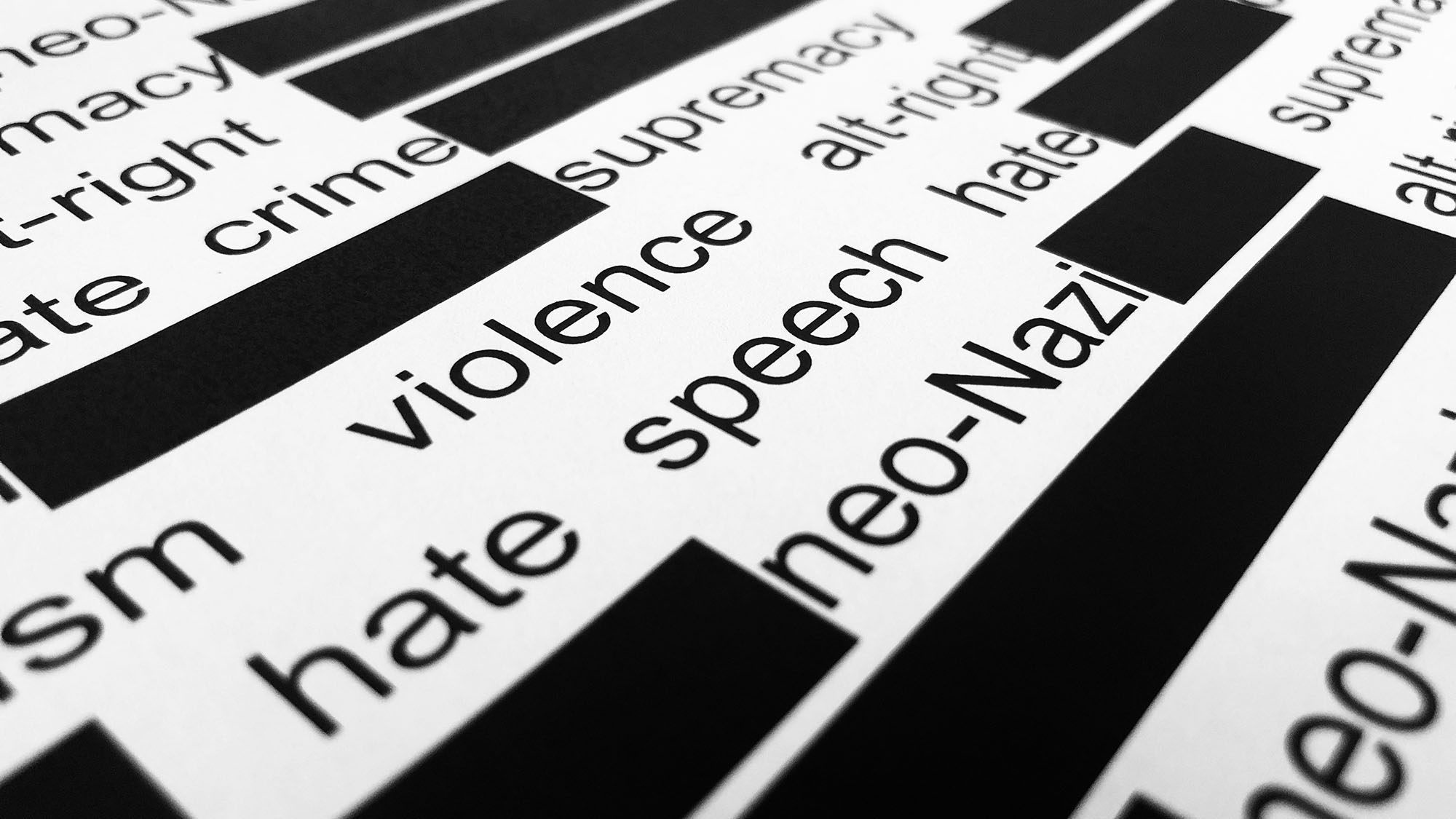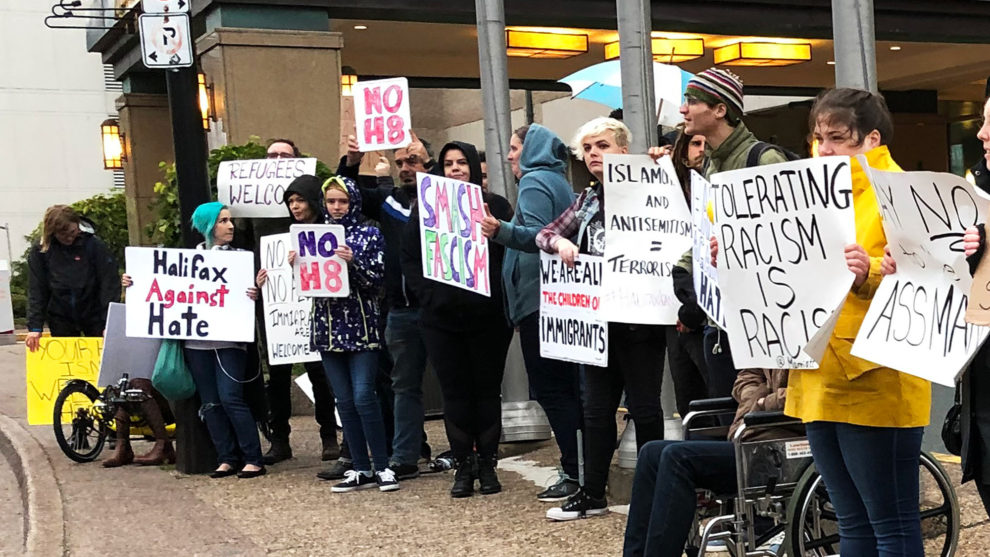Writing the far right

caption
How journalists can report on hate groups without handing them a microphone
Looking at their websites, here’s what you learn: they stand up to moral wrongdoing. They want to help Canadians. They want to protect women, children and the elderly. They believe in basic human rights. They’re anti-pollution.
They’re charitable. Tolerant. Patriotic.
But, as executive director of the Canadian Anti-Hate Network Evan Balgord would tell you, they’re also liars.
He says members of far-right groups are manipulators. They’re experts at misrepresenting themselves. When they commit charitable acts – such as feeding the homeless (but only the white homeless), picking needles off the streets, or washing away graffiti – they do so in the hope of bettering their public image.
When they talk to you, they do so in their own manufactured dialect.
It’s not “racism,” it’s “pride in Canadian heritage.” It’s not “ethnicity,” it’s “culture.”
“If your family’s been here for three generations, but you’re not Brit or French,” says Balgord, “they don’t accept that citizenship makes you Canadian.”
It’s commonly accepted that Canadians are polite. Inclusive. Known for apologizing even when not wrong. Canada is almost the last place someone would expect to find an active subculture of far-right beliefs and white supremacy.
Yet hate groups and hate crimes in Canada are on the rise. According to Barbara Perry, a social sciences professor at Ontario Tech University in Oshawa, Canada now has around 300 active far-right hate groups. (In 2015, she estimated just over 100.) Some are new, while others are new chapters of years-old groups.
With a growing climate of hate in the country, journalists from coast to coast are bound to write about far-right rallies and the hate crimes that members of these groups commit.
Journalism ethics dictate that stories be fair, accurate and balanced. When reporting on hate, though, is it fair and balanced for writers to give a voice to white supremacy? If so, at what point does a story no longer spread awareness, and instead provide a platform?
Hate on the rise
In 2014, according to Statistics Canada, there were 1,295 reported hate crimes in the country. In 2017 there were 2,073; a year later, 1,798. Perry believes only 30 per cent of hate crimes are reported. The reason this number is so low, she says, is because victims may fear retaliation, lack confidence that law enforcement would take action, or do not realize that the crime against them is part of a larger issue. Most hate crime victims were targeted due to their race or religion.
Perry says there is “a symbiotic relationship” between the increase in hate groups and hate crimes. The growing visibility of the far-right may give potential perpetrators of hate crime the idea that it’s okay to act out their racist beliefs.
She believes social media plays a large role in the growth of the far-right. Hate groups use the Internet to recruit new members and strengthen not only their local and national identities, but also a global identity rooted in white nationalist beliefs.
According to Perry, hate groups are worth being written about, even their nonviolent activities. The presence of white supremacists, she says, poses a threat to an immigrant’s sense of belonging in a new country. It’s important that journalists let citizens know about the far-right’s existence in their neighbourhoods.
Journalists should be “deconstructing narratives rather than just putting them on the table,” says Perry. “What’s wrong with saying that refugees pose a threat to our way of life? Ask that question and answer that question.”
Combating hate
Part of Balgord’s job with the Canadian Anti-Hate Network involves monitoring hate groups and writing articles for the organization’s blog. He does not think it’s necessary to interview and quote members of hate groups, because they are not likely to tell the truth about their beliefs. Balgord rarely talks to the far-right; any information he has about them he has from watching them over the years.
If reporters must quote a member of a hate group, Balgord suggests they let the group member say, “I’m not racist, I just ‘insert racist thing here,’” then follow the quote with an “info dump.” Explain why the group is, in fact, hateful and racist. Let them be “damned by their own words.”

caption
People at a Halifax Against Hate rally make their feelings known.Since its founding in May 2018, the Canadian Anti-Hate Network has filed criminal complaints against more than 10 individuals, including complaints under section 319 of the Canadian Criminal Code, which covers “public incitement of hatred.”
The organization also shut down a neo-Nazi podcast, This Hour Has 88 Minutes. After being written about in a VICE article, the podcast’s host shut it down, fearing further exposure would lead to legal consequences.
The Canadian Anti-Hate Network watches between 30 and 50 groups, including militant groups and “free speech clubs.” It also monitors some individuals who involve themselves with multiple groups.
According to Balgord, hate groups grow in response to an influx of immigrants, and when pro-multicultural leaders come into power.
“A lot of groups had online presences as a reaction to Justin Trudeau’s (2015) election,” he says. “It wasn’t like Islamophobia wasn’t a thing then, but it became more and more of a thing. That kind of became a defining feature of these far-right groups.”
Writing hate
For Romayne Smith Fullerton, an information and media studies professor at the University of Western Ontario, a fair and balanced story is one that assesses a situation accurately. It’s not a reporter’s job to pick sides, but to provide the facts. In her opinion, it would not be fair journalism to quote a holocaust denier in a story about the holocaust.
“You’re responsible to know who these people claim to be and who they, in fact, are,” Fullerton says. “A lot of Canadian media – not intentionally, but perhaps because they didn’t ask enough tough questions – may have legitimized a group like the yellow vest movement.”
Lisa Taylor, a journalism professor at Ryerson University, says any quotes from hate group members should be kept away from the lead of a story. She believes reporters should not let hateful quotes stand on their own; instead, provide the facts and context behind them.
When writing about the far right, she says, avoid clickbait. Don’t add a photo of racist graffiti, for example, if you can write the story without it. The photo provides no thoughtful insights.
“It’s journalists’ human natures to look for quotes that have the most powerful language,” says Taylor. When it comes to quoting white supremacists, though, she believes “using that quote selection mechanism, that works so well in other contexts, can be problematic.”
Appeal of the far-right
In 1992, Elizabeth Moore was a high school student in Toronto when a male friend introduced her to the Heritage Front – a (now-dissolved) white supremacist group. Her school was quickly growing more diverse, with an influx of new students who were still learning English. The introverted Moore found the diversity hard to take in. She struggled to communicate with and relate to her new classmates.
Times were confusing.
Heritage Front gave her answers and – for the first time – a sense of power. As part of the group, Moore wrote articles for their magazine and recorded “news of the day” messages on their hotline.
But what went on behind closed doors was different than what Heritage Front portrayed in its flyers. As one of the few women in a misogynistic group, Moore realized the hatred sooner than she would have if she were a man. Her “aha” moment came at a Heritage Front party. She looked around the room thinking, “the only thing that we have in common, the only reason that we are here … is because of who we hate.”
In 1994, Moore reached out to Bernie Farber – then CEO of the Canadian Jewish Congress – who had previously spoken at her university. He took her to Toronto’s Holocaust Museum, where she realized, “I was going around thinking that other people were lesser than me. I was the one who was lesser than them.”
Today, she advocates against hate. Moore speaks to schools and community groups, telling people that radicalization can happen to anyone. She was an honour roll student. The “girl next door.” Yet it happened to her.
“They take broken people and break them further.”
Moore believes there are times to quote white supremacists, such as when they commit hate crimes. But she says journalists should avoid giving them the respect they give everyone else. Don’t let them justify and explain their actions. Don’t let them tell their own tale.
“The Jews had absolutely nothing, and they fought with everything they had left to maintain their humanity,” she said to Farber as they left the museum. “I had everything, and I gave mine away.”
Farber responded: “the beauty of humanity is you can always get it back.”
About the author
Kristin Gardiner
Kristin is a Prince Edward Islander currently working in Halifax. Her journalistic interests lie in copy editing and longform features.
